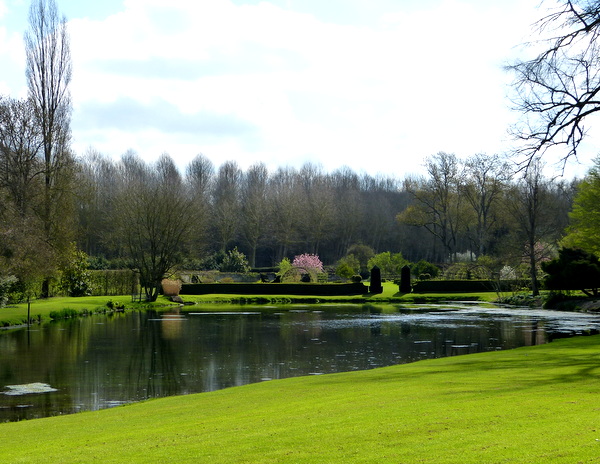
In the Loire Valley, the Jardin du Plessis is not quite a French garden, but not quite an English garden either.
FRANCE Loire Valley – Madame Rosamée Henrion and I paused in our stroll along the aptly named Magnolia Walk to take in an overview of her garden – the Jardin du Plessis. Centered around a lake, the garden fills a small valley of approximately four acres, part of a larger estate in her family’s ownership since the 15th century. In 1960 Madame Henrion inherited the property.

Madame Henrion pauses in her garden. In background, a restored house and 15th century arch.
It was a blue-sky morning in early April. The garden, Madame Henrion explained, would not evolve into full glory until the calendar flipped forward several weeks. Under-plantings of fragrant plants beneath the magnolias along our walk were yet to come. As were the roses and the flower gardens organized by color – yellow and white, pink and blue, deep shades of purple. “Later in the season there is fragrance and color at every turn,” she commented.
Early spring garden delights …

The garden, even in early April, is glorious with spring-time flowering bulbs, shrubs, and trees.
Nevertheless, the garden was quite glorious to my eyes, with a small stream and waterfall tumbling into the lake and spring- flowering shrubs and trees in full blossom-billowing splendor.
A garden both French and English …
“It’s not quite an English garden, but not quite a French one either.” Madame Henrion pointed out the clipped yew hedges punctuated with topiary that organize spaces as typically French, the sweeps of lawn and free-form planting of shrubbery and trees as English. “I borrowed whatever pleased me from each,” she said, crediting visits to Highgrove, the royal gardens nurtured by the Prince of Wales since the 1980s, as her greatest source of English landscaping inspiration.

Clipped hedges punctuated with topiary throughout the property are quintessentially French .
As we walked along, Madame Henrion described the property at the time of her inheritance. “All but abandoned since 1914. The house and outbuildings in disrepair, the entire valley strangled in overgrowth.”
Restoration came about slowly …
Restoration came about bit by bit, with the Henrion family, which included four boys, coming down from Paris for country getaway weekends.
Today, it is hard to visualize the property in disrepair, its centerpiece lake surrounded by immaculate lawns and gardens, its neat line up of restored structures nestled against the edging hillside.
Stone steps delivered us into the heart of the garden. Along the way, at the top of the waterfall, we stopped to admire the giant-leafed Gunnera, a Brazilian native, flourishing in one of the valley’s many microclimatic niches Madame Henrion discovered via plant trial and error through the years.

Stone steps and a waterfall lead visitors into the heart of the garden and entice them to explore.
“And here, Actinidia melandra, very rare,” Madame identified a vine clambering up the exterior of an outbuilding as we passed by, a plant introduced to England’s botanical world in 1910 by famous plant hunter Ernest Wilson from a collection expedition to China.
“Plants stay in the garden only if they are happy,” she said. “I don’t have time to put a scarf on them in winter, a sunhat in summer.”
Village of Sasniéres right next door …
Although the outside world seemed far away as we strolled toward the far end of the garden, a church spire glimpsed through the trees made it known that the tiny village of Sasniéres is right next door. In 1995, Madame Henrion was named mayor of Sasniéres, a position far less demanding than that her brother-in-law, Valéry Giscard d’Estang, had taken on 20 years before as president of the French Republic.

While wandering the quiet garden, the world seems far away. Yet, the village is right next door.
One of the first items to come before the council she headed was an approval request by a Sasniéres property owner to open his garden for touring one day a year. The council voted “yes,” while Madame Henrion thought to herself, “My garden is every bit as beautiful and interesting as his. Why not request to open mine one day a year?”
Through the years, Jardin du Plessis “one day a year” multiplied to today’s five days a week, April to November.
Gardening efforts accelerated …
With the 1996 public opening, Madame Henrion accelerated her gardening efforts. Each season offered expansion and new beds of color. In 2004, her garden was officially named a Jardin Remarquable, a designation created by the Minister of Culture in 2003 to officially recognize France’s most magnificent gardens.
An idea direct from England …

Espaliered, varieties of apples, underlined with plantings, await blossoming in weeks to come.
Following the perimeter of the lake, we stopped to meet the dogs as we made our way toward “an idea directly stolen from Highgrove,” a long alleé of espaliered apple trees with varieties chosen to ensure a parade of spring blossoms.
Circling back, there was a snake-bark maple and a peeling maple to admire – “chosen for their interesting bark” – and a 15th century stone archway to pass under.
We returned to where my visit had begun, at the old water mill turned reception area, gift shop and tea room. Who could pass up a slice of one of the cakes on display, carrying it out with a cup of tea to one of the umbrella-shaded tables in the courtyard? Not I.

If you go …
Jardin du Plessis is open Thursday through Monday, 10 a.m. to 6 p.m., April to November. A modest entrance fee is charged. Web: www.jardin-plessis-sasnieres.fr .
